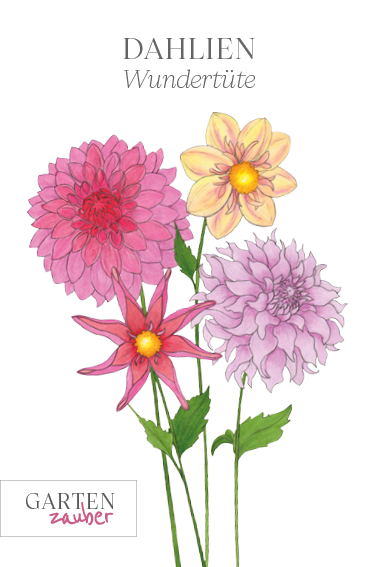Storing dahlias correctly
Since dahlias originate from sun-drenched Mexico, the tubers are very sensitive to frost and should be stored during the winter. They can only survive outdoors in extremely mild winters in very sheltered locations. If they are exposed to frost, they will not survive the winter. Mid-November is usually the ideal time to dig the tubers out of the ground. Then they will reward us again next year with particularly long-lasting, lush, and beautiful blooms.

As soon as the first night frosts appearmustThe dahlias are being prepared for their winter hibernation. While the tubers can remain in the ground for a while after the first frost, gaining some strength for the following spring, they should be stored quickly before a real frost sets in, when the soil freezes right down to the tuber's depth. We'll tell you what you need to keep in mind:
- Now's the time to label the flowers with small tags, noting the variety, flower color, and height. This way, you can quickly decide next year which plants will best be placed together and which ones might be planted in the back row due to their taller growth.
- Wait until the dahlia foliage wilts before digging them up. Before digging, cut all the stems a hand's breadth above the ground once all the flowers have faded.
- Then, in dry weather, carefully dig up the tubers with a spade or digging fork and gently tap off any loose soil. Leave some extra soil around the tubers to prevent them from drying out.

Dahlia Mix Grab Bag
We're bringing a colorful surprise to your summer flowerbed with a Garden Magic grab bag full of dahlia seeds. The seeds come from dahlias sustainably grown on our flower farm. All colors and shapes are possible, because growing dahlias from seed means you never know exactly what will grow. A true grab bag, as you can see from the photos!
Through pollination by bees and other insects, different dahlia varieties are mixed to create entirely new varieties. Dahlias can be propagated from cuttings, tuber division, or seed. Both division and cuttings ensure pure varietal propagation, but propagation from seed does not. Thus, the idea of a bag full of anticipation, heart palpitations, and exciting moments, wondering which flower color and shape will enchant us.
We wish you a summer full of dahlia happiness!
Details :
Sowing indoors/greenhouse: Beginning to end of March
Sowing depth: Cover with a maximum of 0.5 cm of soil
Germination time: 7-14 days at 18-20°C
Height: 80-180 cm
Planting distance: 30 cm
Flowering time: from July
Location: Sunny
Water consumption: Medium
Soil: Loose, permeable, humus-rich soil
Fertilization: Fertilize regularly
Cultivation tips :
The seeds should only be lightly covered with soil and kept moist at all times. Warmth is very important, which can be provided by a heat mat or a warm windowsill. Once the seeds germinate after about 10 days, they should be placed in a bright location, otherwise they will grow tall and flop over. The more light, the better. Once the first pair of true leaves has formed, the young plants can be transplanted into larger pots filled with potting soil.
Once the dahlia reaches a height of approximately 20 cm, it should be pinched, meaning the main stem is shortened. To do this, it is cut above the second pair of leaves. This branching will produce side shoots, making the dahlia more compact, bushy, and flower-rich.
At the end of April, the young plants can be hardened off during the day at a temperature of 12 degrees Celsius to ensure they have a good start to the season.
Dahlias are not frost-hardy and may only be planted outdoors after the Ice Saints.
For tall varieties, support is recommended.
Use :
cut flower
Food for insects
Cut flower :
The long blooming period makes the dahlia a perfect flower for summer bouquets. Dahlia buds don't open in the vase and should therefore only be harvested once the flower has opened.
The best time to cut is early in the morning, when they are no longer wet with dew, or in the evening. Depending on the variety, dahlias can last several days in a vase.
Contents :
approx. 10 seeds
Store in a cool, dry place.
- Let the tubers dry for a few days in a warm, frost-free place. Check the tubers for damage and rotten spots and store only the undamaged, healthy ones. Rot spreads quickly and can destroy all the tubers.
- Line a wooden box with newspaper and fill it with a thin, dry layer of peat and sand. Place the tubers on top and cover them with the peat and sand mixture. Make sure the tubers aren't touching each other.
- The box is best stored in a frost-free, cool, and dry place. 6 degrees Celsius is ideal. If the humidity in the storage room is too high, there is a risk of the tubers rotting. If the air is too dry, they may shrink. If the room is too warm, the tubers may even sprout prematurely.
TEXT: Victoria Wegner




































































































